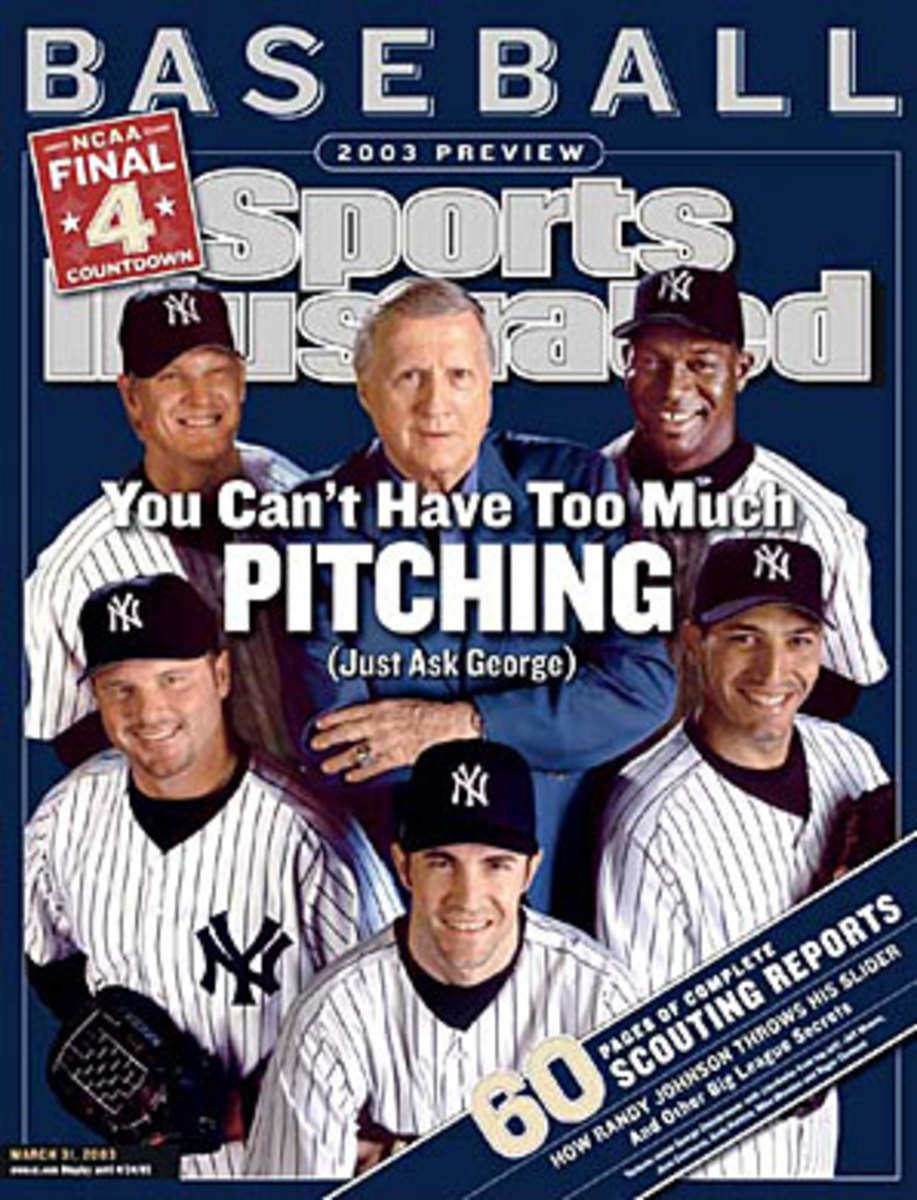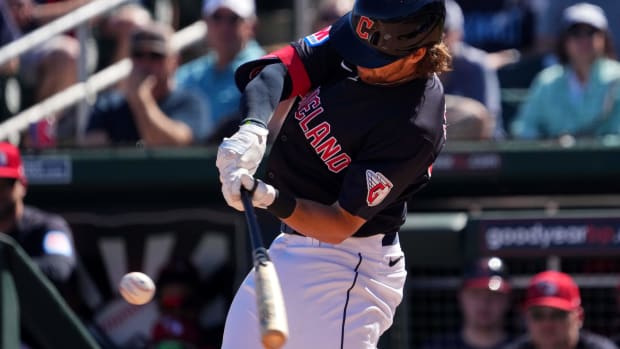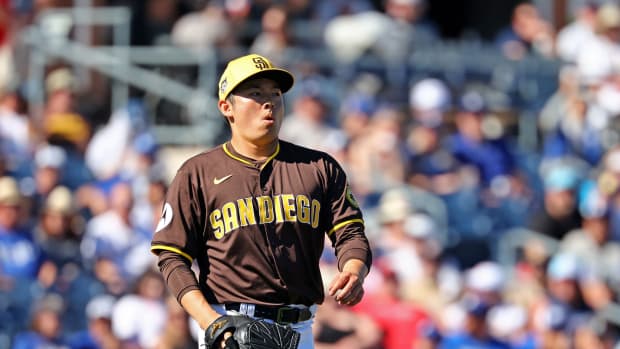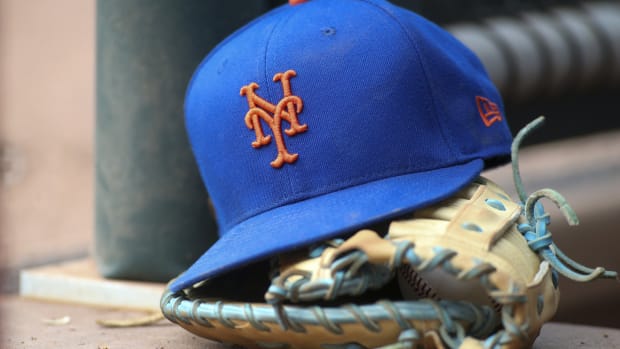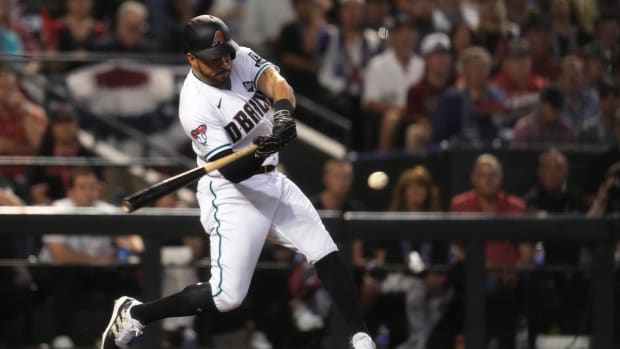JAWS and the 2014 Hall of Fame ballot: Mike Mussina
Mike Mussina (bottom) sometimes had a hard time standing out among all the talent on the Yankees' pitching staffs. (Walter Iooss Jr./SI)
You have reached your limit of 4 premium articles
Register your email to get 1 more
The following article is part of my ongoing look at the candidates on the BBWAA 2014 Hall of Fame ballot. For a detailed introduction to JAWS, please see here. For the schedule, see here.
Unlike three other pitchers on this year's Hall of Fame ballot, Mike Mussina didn't reach 300 wins in his career. Nor did he ever win a Cy Young award, in part because one of his fellow candidates practically stole one out of his hands thanks to superior run support. As well as he pitched in the postseason, his teams never won a World Series, because even the best relievers sometimes falter, to say nothing of what happens to the rest of 'em.
Though lacking in those high-visibility accomplishments, Mussina nonetheless strung together an exceptional 18-year career, one spent entirely in the crucible of the American League East, with its high-offense ballparks and high-pressure atmosphere. A cerebral pitcher with an expansive arsenal that featured a 93 mph fastball and a signature knuckle-curve, he not only missed bats with regularity, he had pinpoint control.
In a prime that coincided with those of Roger Clemens, Randy Johnson and Pedro Martinez, "Moose" never led the league in either strikeouts or ERA, but he ranked in the league's top five six times in the former, seven in the latter. He earned All-Star honors five times, and received Cy Young votes in eight separate seasons across a 10-year span, at one point finishing in the top five four times in five years. Despite his lack of titles, he put together a strong postseason resume.
In fact, despite a late-career dip from which he recovered in memorable fashion, Mussina's resume as a whole is strong enough for the Hall of Fame. He wound up delivering tremendous value across his career, and holds up well in comparison to his contemporaries and to those already enshrined. On a ballot overstuffed with flashier candidates, however, he won't come anywhere close to getting in this time around, and as voters make tough choices about which qualified candidates to leave off, there's reason to be concerned he may not get enough support to reach the five percent minimum. At best, he may be in for a long, Blyleven-esque climb from a meager debut to the requisite 75 percent.
Before we delve further into his career, a disclaimer: Regular readers know that I usually avoid dwelling upon pitcher win totals due to the fact that in this increasingly specialized era, they owe as much to adequate offensive, defensive and bullpen support as they do to a pitcher's own performance. While one needn't know how many wins Mussina amassed in a season or a career to appreciate his true value, the 20- and 300-win marks are an inextricable part of his particular story.
Pitcher | Career | Peak | JAWS | W | L | ERA | ERA+ |
Mike Mussina | 83.0 | 44.5 | 63.8 | 270 | 153 | 3.68 | 123 |
Avg HOF SP | 72.6 | 50.2 | 61.4 |
Mussina was born in Williamsport, Penn. — the birthplace of Little League Baseball — and grew up in nearby Montoursvile, a tiny town of less than 5,000. A strong student as well as an outstanding pitcher in high school, he nearly earned valedictorian honors, but according to legend may have tanked a test in order to fall short and thus avoid having to speak at graduation. Despite being considered one of the country's top prospects out of high school, he chose to attended Stanford on a baseball scholarship. He helped the Cardinal win the College World Series as a freshman in 1988 and earned his economics degree in three-and-a-half years.
The Orioles made Mussina their first-round selection in 1990, the 20th overall pick of the draft, and signed him for a $225,000 bonus. He didn't spend long in the minors; Baltimore sent him straight to Double A Hagerstown, and while he made just nine starts between there and Triple A Rochester, he was ranked 19th on Baseball America's Top 100 Prospects list the following spring. After a strong showing in 19 starts at Rochester, he debuted for the Orioles on Aug. 4, 1991. The 22-year-old righty threw 7 2/3 innings against the White Sox, allowing only a solo homer to fellow ballot newcomer Frank Thomas, but lost because ageless knuckleballer Charlie Hough spun a five-hit shutout. Though stuck on a club bound for 95 losses, Mussina stood out in his 12-start trial; his 2.87 ERA was almost exactly half of the other Baltimore starters' collective ERA (5.55).
That abysmal season marked the Orioles' fifth sub-.500 finish out of six, but Mussina helped put the franchise back on the road back to respectability. Already remarkably polished as a pitcher, he assumed the mantle of staff ace, a role that 1989 overall number 1 pick Ben McDonald couldn't fulfill. Mussina helped the O's improve to 89 wins in 1992, tossing 241 innings of 2.54 ERA ball while going 18-5, a performance that earned him All-Star honors and fourth place in the Cy Young voting. His ERA ranked third in the league and his walk rate (1.8 per nine) and WAR (8.2) ranked second, the latter trailing only Clemens' 8.8. Not surprisingly, his heavy workload carried a cost; shoulder soreness limited him to 167 2/3 innings the following year, and he was roughed up for a 4.46 ERA.
Mussina restored his claim as one of the league's top starters in the strike-shortened seasons. In a 1994 Sports Illustrated profile, Tom Verducci described him inventing a cut fastball on the fly to escape a jam, quoting batterymate Chris Hoiles. "Well, I guess if you're going to use that pitch, we ought to have a sign for it." Verducci continued:
What's most impressive is that from 60 feet, six inches, Mussina can dot the i in his autograph with any one of six pitches. He has three fastballs (a cutter, a sinker and a riser), two curveballs (a slow curve and the knuckle curve) and an astonishingly deceptive changeup that is his best pitch. The rest of the pitching population is usually content to throw all changeups on the outer third of the plate. But Mussina is so adept at spotting his changeup that Hoiles often gives a location sign when calling for the pitch, a rare practice.
Mussina finished fourth in the AL ERA in both 1994 and 1995 (3.04 and 3.29, respectively), with fourth- and third-place finishes in WAR (5.4 and 6.1, respectively). He also led the AL in wins (19) and walk rate (2.0 per nine) for the only times in his career in 1995, but finished just fifth in the Cy Young balloting, not that he had any business winning over Randy Johnson (18-2, 2.48 ERA, 8.6 WAR). The Orioles went 63-49 in 1994, in position to challenge for the new wild card spot when the strike hit, but they finished just 71-73 the following year.
In 1996, under new manager Davey Johnson, the star-studded O's — featuring future Hall of Famers Roberto Alomar, Eddie Murray and Cal Ripken, plus Brady Anderson, Rafael Palmeiro and more — came together to win 88 games, good enough to secure the wild card. Aided by an offense that cranked out 5.82 runs per game (third in the league), Mussina overcame his own gaudy 4.81 ERA (still a 103 ERA+) and again won 19 games. He also struck out 204 hitters, not only good for fourth in the league but the first of four times he'd reach the 200 plateau. In his first taste of playoff action, Mussina wasn't particularly effective, allowing a combined nine runs in 13 2/3 innings against the Indians in the Division Series and the Yankees in the ALCS; he was done in by a three-run Cecil Fielder homer in the eighth inning of the latter start.
In 1997 Mussina improved to a 3.20 ERA (sixth in the league) and 218 strikeouts (fourth) in 224 2/3 innings as the Orioles stormed to 98 wins and their first AL East title since 1983. He was stellar in the playoffs, pitching to a 1.24 ERA in four starts, striking out 41 in 29 innings. Facing the Mariners in the Division Series, he outdueled the Big Unit in both Games 1 and 4, administering the coup de grâce with a combined two-hitter in the latter. In his coverage for SI, Verducci harped on Mussina's repeated failure to win 20 games but wrote approvingly of his pitching style, "What makes Mussina so difficult to hit is that he morphs the best qualities of a power pitcher and a finesse pitcher. At times he blew his fastball at 93 mph past Seattle. Other times he dropped in knuckle curves when he was behind on the count."
Facing the Indians in Game 3 of the ALCS, Mussina was even more brilliant, whiffing 15 over seven innings while allowing just three hits and one run. Even so, the Orioles lost 2-1 in 12 innings when Marquis Grissom stole home with the winning run. As agony goes, that was nothing compared to Mussina winding up on the short end in Game 6 despite eight innings of one-hit shutout ball. The Orioles and Indians remained deadlocked until the top of the 11th, when Armando Benitez served up what proved to be a pennant-clinching solo homer by Cleveland's Tony Fernandez.
Mussina had signed a below-market three-year, $21.5 million contract extension in May, and despite the Orioles falling short that fall, their future looked bright. Alas, a feud with owner Peter Angelos led Johnson to resign the same day he won AL Manager of the Year honors, and the O's wouldn't post a winning season again until 2012.
Mussina played out the string as Baltimore collapsed into 70-something win ignominy, averaging 216 innings with a 3.60 ERA (129 ERA+), 5.0 WAR and his typically stellar 4.0 strikeout-to-walk ratio. He finished second in the Cy Young voting in 1999, the best showing of his career, but that was the year Pedro Martinez went 23-4 with a 2.07 ERA (243 ERA+) and won unanimously.
As the Orioles' roster was ripped apart, Angelos took a glacial approach to Mussina's pending free agency, gradually raising the team's offer from five years and $50 million to six and $78 million, albeit with $12 million deferred. Turned off by the slow pace of negotiations and by the team's protracted rebuilding process, Mussina instead opted for a six-year, $88.5 million deal from the Yankees, who were riding a streak of three straight world championships. "There have been only a couple years in my career when I knew we were going to win," he said of his time in Baltimore upon signing. "That's what I look forward to experiencing again." The new deal made Mussina the game's fifth-highest paid player.
Mussina and the Yankees did their share of winning in 2001. In his pinstriped debut on April 5, he tossed 7 2/3 innings of scoreless ball against the Royals, getting the win in a 1-0 squeaker. On May 1, he threw a three-hit, 10-K shutout against the Twins. On Sept. 2 at Fenway Park -- in a match up against David Cone, the man he replaced in the Yankees' rotation -- he struck out 13 and came within one strike of completing a perfect game, allowing a two-out, two-strike single to Carl Everett before closing out a 1-0 win. In the New Yorker, Roger Angell's memorable account found Mussina shocked and dour in victory, Cone, who himself had authored a perfect game for New York two years earlier, rejuvenated even in defeat.
For that first year in pinstripes, Mussina delivered a 3.15 ERA (143 ERA+), his lowest mark since 1994. That ERA and his career highs in both strikeouts (214) and strikeout-to-walk ratio (5.1) all ranked second in the league, while his 7.1 WAR ranked first for the only time in his career. Alas, he finished fifth in the Cy Young race, losing to teammate Clemens, who had a vastly inferior season save for the W's (20-3, 3.51 ERA, 5.6 WAR) thanks to 5.7 runs per game of offensive support, the league's fourth-highest rate among ERA qualifiers. Mussina, who had gone 17-11, had received just 4.2 runs per game, the league's fifth-lowest rate.
That year, the Yankees won 95 games and their fourth straight pennant, with Mussina again making a strong postseason showing. With the Yankees down 2-games-to-0 in the Division Series against Oakland, he delivered seven shutout innings in Game 3, aided by Derek Jeter's legendary flip play. After a solid six-inning, two run start in Game 2 of the ALCS against the Mariners, he was roughed up by the Diamondbacks in the World Series opener, but rebounded to strike out 10 in eight strong innings in Game 5, which the Yankees won in the 12th. The Yankees ultimately came within one inning of their fourth straight title — and Mussina's first — but Mariano Rivera unraveled in the ninth inning of Game 7. So it goes.
After a so-so 2002, Mussina helped the Yankees back to the World Series in 2003. He ranked eighth in ERA (3.40) and fifth in WAR (6.6) for the 101-win AL East champs, though his October had its ups and downs. He worked seven innings in a losing cause against the Twins in Game 1 of the Division Series, was knocked around by the Red Sox in the ALCS opener and wound up on the short end despite a 10-strikeout performance in 6 2/3 innings in Game 4. When Clemens fell behind 4-0 and failed to retire any of the three batters he faced in the fourth inning of Game 7, manager Joe Torre summoned Mussina out of the bullpen for the first relief appearance of his professional career. He was nails: With runners on first and third, he struck out Jason Varitek on three pitches, then got Johnny Damon to ground into a double play to escape the jam. He worked three scoreless innings, an unsung hero in a game the Yankees won in 11 on Aaron Boone's walkoff homer.
Mussina started Game 3 of the World Series against the Marlins, battling Josh Beckett to a 1-1 draw through seven innings despite a 39-minute rain delay in the fifth. The Yankees took the lead in the eighth and broke the game open in the ninth, giving them a 2-1 series lead. He was lined up for Game 7, but the call never came, as New York lost each of the next three games.
Things started going downhill for Mussina in 2004, his age-35 season, as he lost six weeks to elbow tightness. From 2004-07, he averaged just 173 innings a year due to injuries, never topping 200. His 4.36 ERA over that span was still good for a 102 ERA+, but that owed to one exceptional season (2006, 3.51 ERA, 129 ERA+, 5.0 WAR) offsetting three mediocre ones; for the stretch, he averaged just 2.9 WAR.
The Yankees officially declined Mussina's $17 million option for 2007, though they wound up reworking it into a two-year, $23 million deal. Initially, they might have wished they hadn't, as Mussina was pounded for a career-worst 5.15 ERA while battling back and leg woes. After a three-start stretch in August in which he was rocked for 20 runs in 9 2/3 innings, he was dropped from the rotation, though he salvaged some dignity after returning two weeks later and reeling off a stretch of 13 2/3 scoreless innings.
He salvaged even more dignity the following year, defying both his age (39) and a rocky opening in which he was hit for a 5.75 ERA over his first four starts. He stayed in the rotation all year, making a league-high 34 starts, tossing 200 1/3 innings — his first time above 200 since 2003 — and finishing with a 3.37 ERA. The real story, aside from the Yankees missing the playoffs for the first time since the strike, was that he finally reached 20 wins. He did it by allowing just one run over his final 17 innings across three starts. The last came in Fenway Park, the site of his crushing near-perfecto, as the opener of a doubleheader on the final day of the season. Mussina tossed six shutout innings against the wild-card-winning Red Sox and left with a 3-0 lead. Boston cut it to 3-2 in the eighth, but the Yankees scored three in the ninth, giving Mussina the 20th win that had long eluded him, and making him the oldest to attain that plateau for the first time.
That win was the 270th of his career. Realizing that a pursuit of 300 might mean a three-year slog, and feeling the strong pull of Montoursville, he opted to retire instead, virtually unprecedented for a 20-game winner. As The New York Times noted at the time, in the previous century, only three pitchers had won at least 20 games in their final seasons: Eddie Cicotte and Lefty Williams in 1920, just before Commissioner Landis banned them for life for their involvement in the Black Sox scandal, and Sandy Koufax in 1966, when he decided to retire due to elbow problems. Mussina had nothing forcing him to stop the way those pitchers did; on the contrary, he had millions of reasons to stay, in the form of dollars on his next contract. In walking away, he followed the old showbiz adage, "Always leave 'em wanting more."
Two hundred and seventy is not 300, but even so, Mussina ranks 33rd all-time in wins, with a total higher than Hall of Famers Jim Palmer (268), Bob Feller (266), Bob Gibson (251) and 29 other enshrined starting pitchers. Moving beyond that — seriously, I'm done with the wins talk now — his 2,813 strikeouts rank 19th all-time and his 7.1 strikeouts per nine ninth among pitchers with at least 3,000 innings. That's in part a product of pitching in an era where strikeout rates were almost continually on the rise, but it's impressive nonetheless. Even more impressive is that his 3.58 strikeout-to-walk ratio is second only to Curt Schilling among pitchers with at least 3,000 innings since 1893, when the distance from the rubber to home plate was lengthened to 60-foot-6.
As for the postseason, Mussina may not have won a ring, but his 3.42 ERA in 139 2/3 innings is no small feat given the high-scoring era; it's 0.26 lower than his regular season ERA, which itself was 23 percent better than the park-adjusted league average. Aided by the three tiers of playoffs during the bulk of his career, his 145 postseason strikeouts rank fourth all-time, while his 9.3 strikeouts per nine is second among the 22 pitchers with at least 100 postseason innings (Johnson is first at 9.8). Sadly, Mussina's teams only won nine of his 23 postseason starts, because they supported him with just 3.1 runs per game; only four times did they even give him more than four runs. He had a few dud starts (three of less than five innings) among them, but it's tough to pin his failure to win a ring on him.
As for the advanced metrics, Mussina stands tall thanks to his combination of run prevention and strikeouts (for which he doesn't have to share value with his fielders). His 83.0 career WAR ranks 23rd all-time, ahead of 39 of the 57 enshrined starting pitchers; it's 14th among post-World War II pitchers. That total is 1.6 above fellow candidate Glavine, who has an almost identical career/peak/JAWS line, and 10.4 wins above the average for enshrined starters. Mussina's peak WAR of 44.5 doesn't stack up as well; while it's still 65th all-time, it tops only 20 enshrined starters and is 5.7 wins below the average one. Even so, his 63.8 JAWS is 2.4 points above the Hall average, good for 28th all-time, one spot below Schilling (64.4) and two above Glavine (62.9). He's 132 spots higher than Jack Morris (38.4). His score beats those of 36 enshrined starters. He's good enough for Cooperstown.
Mussina's JAWS score beats those of 36 enshrined starters, and it will still be above the standard once Clemens, Maddux, Johnson, Martinez and Tom Glavine all get their due (the admission of those five would raise the respective bars to 75.1/50.7/62.9). He's good enough for Cooperstown.
Still, the Moose won't be loose in upstate New York anytime soon. On the contrary, Mussina probably has a long road before he gets a bronze plaque. In such heavy traffic, it's probably asking too much even to hope that he approximates Schilling's 38.8 percent debut last year. But like the aforementioned Bert Blyleven, a high-strikeout pitcher from an earlier era whose dominance over hitters and excellence in run prevention was initially overshadowed by his lack of Cy Young hardware, the numbers and the facts are on Mussina's side. It's just going to take some time for them to carry the day.
This article has been updated to correct an error concerning Mussina's start in the 2001 World Series.






























